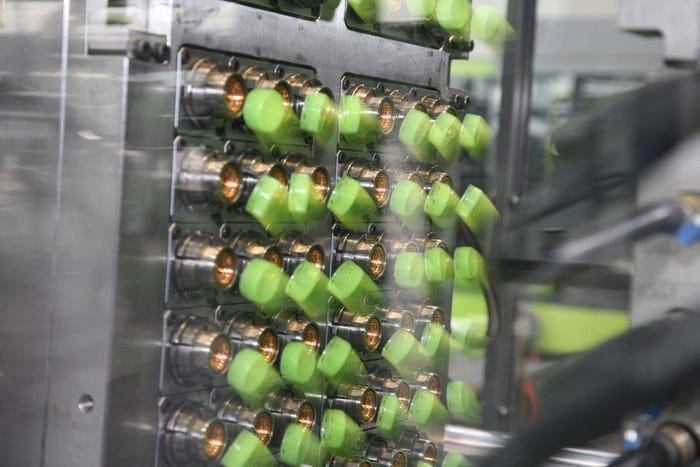Engel demonstrated a high-powered, all-electric cap-molding cell at NPE2012 and disclosed its goal of becoming number one in the bottle cap production niche."Our cap business is growing 30% a year," said Dr. Peter Neumann, CEO of Engel (Schwertberg, Austria) at a press conference, adding: "Our goal is to become number one in the cap business."
April 3, 2012

Engel demonstrated a high-powered, all-electric cap-molding cell at NPE2012 and disclosed its goal of becoming number one in the bottle cap production niche.
"Our cap business is growing 30% a year," said Dr. Peter Neumann, CEO of Engel (Schwertberg, Austria) at a press conference, adding: "Our goal is to become number one in the cap business."
|
Engel e-cap machine is producing 130,000 caps per hour at NPE2012. |
An all-electric ENGEL e-cap 3440/460 US injection molding machine at the show in Orlando, FLA uses a 96-cavity mold, with an hourly production rate of almost 130,000 high-density polyethylene water bottle caps. Cycle time is a crisp 2.7 seconds.
"All-electric injection molding machines are constantly gaining in importance, above all in the field of high-performance and fast running applications," said Walter Jungwirth, Engel global business development manager. "Cycle times of less than 3 seconds and injection speeds of 450 mm per second can be realized."
Energy-intensive accumulator machines have traditionally dominated the market.
“We feel that in the future there will only be all-electric machines in the cap business, “Dr. Neuman told reporters. The e-cap is based on the e-motion machines. Features include Engel’s latest injection unit, increased ejector force and a reinforced clamping drive. Compared to a hydraulic machine, the e-cap reduces energy consumption by more than 40%. Reduced energy consumption will be an increased focus for the high-volume cap machines because engineering limits on cycle time and waste reduction are already near their maximum potential, in the eyes of many machine engineers. The e-caps have clamp forces between 100 and 420 tons.
The machine running at the show has some interesting features. One in particular is a mold from Plastisud (Castelnaudary, France) that replaces a core pull with mechanical sliders. The advantage is elimination of potential hydraulic oil contamination. Dr. Neumann said that he considers Engel's regional relationships with leading-edge tool manufacturers a competitive advantage. "Tool makers are looking for system partners," he said.
Involvement of moldmaking partners in the packaging cells reflects a trend toward systems integration. "Efficiency potential can be developed only when all system components interlink perfectly", said Mark Sankovitch, president, Engel North America (York, PA). For this reason, Engel says it is always responsible for the overall system, including areas implemented jointly with system partners.
The e-cap machine at the show is equipped with a camera and image processing system from IMDvista (Brügg, Switzerland).
In another packaging demonstration at NPE2012, Engel ran a cell making container lids that incorporates two-component molding as well as in-mold labeling. H. Müller (Conthey, Switzerland) developed the IML robot and the mold.
You May Also Like



